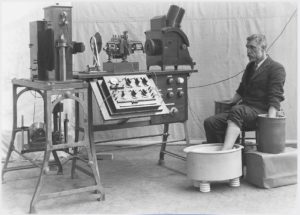Author Archive: Thomas Rich
Pinky Swear!
 My kids were always making promises when they were young. Some they kept, some they didn’t. But they never broke a promise sealed with a pinkie swear.
My kids were always making promises when they were young. Some they kept, some they didn’t. But they never broke a promise sealed with a pinkie swear.
That’s partly because they wouldn’t pinkie swear unless the promise was one they were pretty much positive they would keep. But the ritual of the pinkie swear also clearly pulled a lot of weight.
And that’s the thing about rituals. They have a deceptive power. Marketers tend not to focus on them, and that’s a shame—they’re missing a big opportunity. As a qualitative researcher, I’ve always made a point of looking out for rituals, because they’re often a clue to things of hidden importance.
As a case in point, a few years ago I was conducting research among men being treated for a medical condition with a multi-drug therapy. During the interviews it came out that quite a few of the patients said a prayer when they took one of the three drugs. After a lot of probing as well as supplemental interviews with the doctors who treated them, we learned that the patients were aware that this drug was the least effective of the three. And, of the three drugs, this one had the highest rate of compliance. Patients almost always took it. Had we not noticed the ritual around that one pill, we wouldn’t have discovered some pivotal facts about the patient experience.
So, whether you’re developing marketing strategies or conducting qualitative research, it’s crucial to be aware of rituals. They’re precious gifts from research participants that should be honored and studied closely.
There are four key things to know about rituals.
Rituals are more than mere habits. Habits exist for their own sake – I always lock the door when I leave my house because I want the door locked. Rituals are behaviors that have a higher purpose; my wife and I always share a gin and tonic on the first day of spring because we want to celebrate that winter has ended and we got through it together. So, a ritual elevates a behavior from something commonplace to something profound, even sacred.
Rituals are signals. They are clues that something important is happening. Sometimes a ritual is a sign that something seemingly insignificant is actually profound. Or, sometimes, it’s a way people transform something ordinary into something special. Whether they signal significance or create it, rituals tell us that something’s going on, and that we need to pay attention. They can also be indicators of what people believe and value—there’s no point in adding ceremony to something you don’t care about.
Rituals mark transitions. When a ritual occurs, something essential has shifted, such as:
Physical location
Time period
Social or economic circumstances
Type of occasion
State of mind
Life stage
So, in marking change, rituals create structure and provide transitions with importance. Furthermore, because transitions can be scary, sometimes the role of a ritual can be to provide comfort.
Rituals create a sense of community. They are often shared experiences that bind us together. And they can provide valuable information regarding relationships among individuals—people who share rituals may be more than just casual acquaintances.
So, if marketers and researchers want to uncover what’s actually important, they must look for rituals. Here are some ways to discover and explore rituals:
Train yourself to watch and listen for them. Use the discussion guide to remind you to be on the lookout. This is particularly important when working out in the world, whether you’re in a store, a home, on a street corner, wherever. In fact, one of the most important reasons to conduct research in such places is that you can see rituals right before your eyes.
Don’t be shy about openly asking about rituals.
“What are some rituals you follow on this sort of occasion?”
“Do you have any habitual behaviors associated with this situation?”
“Are there certain practices you always follow with respect to this?”
Look for practices, objects or locations that seem to serve no obvious practical purpose. If, when asked about them, participants have difficulty articulating their reason for being, that’s a pretty good clue you may have uncovered a ritual. Remember—rituals are often private things that carry emotional weight, so probe with sensitivity. It is essential to treat rituals we discover with respect and show our appreciation to those sharing them.
Create process maps. An exhaustive diagram of an occasion that clearly details all its component behaviors enables us to distinguish the elements that have a practical function from those that serve as rituals.
I’ll leave you with one final thought. So many cherished rituals have been taken from us this past year—graduations and proms, religious observances, funerals and weddings, cultural events. This has created a sense of dislocation. We feel untethered without these rituals to provide structure and mark time and space. And so, we’ve been creating rituals, such as 5 o’clock cocktails and zoom yoga. I know people who, for the first time in their lives, have started saying grace at meals. In the absence of old rituals, we’ve created new ones. Human beings are unable to function without rituals in their lives. And that’s why marketers need to seek them out.
My thanks to my friend and colleague Alicia Menanteau, PhD for her input on this post.
Things Look Clearer with the Right Lens.
 The Most Important Research Tool You’re Probably Not Using—Redux!
The Most Important Research Tool You’re Probably Not Using—Redux!
Recently, I was involved in a research study involving patients with familial hypercholesterolemia. FH is a genetic disorder characterized by extremely high cholesterol, and is generally treated with statin drugs. One key topic we struggled with was non-compliance—patients not taking their statins. Our most useful tool in finally understanding this issue turned out to be mindset models—perceptual lenses. One surprising finding: two previously undiscovered user segments emerged, each clearly defined by a cluster of mindsets.
After reviewing the transcripts and screening data, we noticed additional behavioral and demographic similarities among the people in each segment. So, by listening for mindsets, we were able to identify two distinct – and possibly very important – segments for further study, and significantly improved our understanding of compliance. This speaks to the power of mindsets as a market research tool, and that’s why I’m reposting one of my most viewed newsletters – somewhat edited and shortened:
The Most Important Research Tool You’re Probably Not Using.
Of all the posts I’ve written, the ones that get the greatest response are those on mindset models. This isn’t surprising—I like these tools for the same reasons as everybody else. They’re powerful, intuitive, quick to learn and easy to use. And yet, when I talk to marketers and fellow researchers about them, I often get a blank stare. So here’s why everybody should know about mindset models.
A lot of analytical tools are extremely complex. Examples include the Fogg Behavior Model, the Utility Trade-off Model and the Keller Brand Equity Model. I make frequent use of all of these — they’re invaluable. However, they take a long time to internalize and understand, and longer still to master their use.
Not so with mindset models. They can be described in a few minutes and, once explained, you’ll immediately know how to use them. It’s easy to build an extensive set of them; I’ve identified over 30 mindset models that I use regularly.
So, what do I mean by ‘mindset?’ My definition: a mindset is a system of perceptions and attitudes formed by circumstances, intentions, experiences and needs. Put simply, a mindset is how somebody perceives or relates to a situation. When you understand somebody’s mindset, you’re seeing the world from their point of view. That’s a powerful thing to be able to do, particularly if you’re struggling to understand your data, or if you want to look at your data with or a fresh set of eyes. A good metaphor for mindsets is lenses—when you look through the right one, everything comes into focus.
In addition to the other mindsets I’ve written about, here’s another one: possibility versus feasibility. Individuals who have a possibility mindset see situations in terms of what could be, paying little regard to what’s realistic. Those with a feasibility mindset focus on whether or not something can be done, and how.
Why is this important? Because, if you’re assessing new product ideas, mindset will profoundly influence interest level. For instance, early adopters of new technologies tend to have a mindset of possibility—they get excited about the promise of a new idea, and don’t get hung up on why it might not work. So, when communicating with early adopters, marketers should account for this. On the other hand, later adopters tend to have a mindset of feasibility, focusing on potential problems and shortcomings. That’s why they choose to wait to try, why marketers should probably not focus on selling new technologies to these consumers, and why communications aimed at them might do well to focus on a product’s proven track record.
It’s also important to be aware of these mindsets when conducting ideation or co-creation sessions—participants who can’t leave behind a feasibility mindset are unlikely to be able to contribute. So, if you’re recruiting consumers for such an event, a few attitudinal screening questions can greatly increase your chances of success. It’s also a good idea to include exercises to foster possibility thinking.
Making use of mindset models is easy—just get into the habit of listening for the role mindsets are playing in perceptions, attitudes and behaviors. If you’re having difficulty understanding people’s opinions, think about what their mindset might be. Remember that every mindset has its own logic, and if you can identify the operating mindset, points of view will start to make more sense. I have a checklist of questions I routinely ask myself to help focus on mindsets:
-
What mindsets are evident?
-
How are they shaping perceptions?
-
What behaviors are they driving?
-
What can they tell us about segments?
-
What are the implications for branding and tactics?
Refer to this list when conducting research, reviewing data, developing brand strategies or tactics, and when arguing with your significant other. After a while, you’ll find you’re in the habit and won’t even need to think about it. Then you’ll be a Master of Mindsets!
For more information an specific mindsets, click these links to the TMRA website:
Original Post: https://thomahttps://thomasmrich.com/2020/01/09/the-most-important-research-tool-youre-probably-not-using/
Scarcity: https://thomasmrich.com/2019/09/25/why-being-poor-is-so-expensive/
Maximizing & Satisficing: https://thomasmrich.com/2019/08/21/when-good-enough-is-good-enough-2/
Evolutionary Psychology: https://thomasmrich.com/2019/10/28/on-the-benefits-of-generosity/
Morality: https://thomasmrich.com/2020/10/09/the-elephant-in-the-room/
Loneliness: https://thomasmrich.com/2020/07/13/remember-eleanor-rigby/
Here’s Looking at Me, Kid.
 How we see ourselves is central to how we decide among alternatives.
How we see ourselves is central to how we decide among alternatives.
Last summer I wrote a post about my Utility Tradeoff Model. Since then, quite a few of you have asked me to say more about the various tradeoff currencies. In particular, people really want more information about self-esteem. This makes sense, as qualitative research is indispensable to understanding self-image issues, and has been since its beginning. Remember the Betty Crocker cake mix story in that Utility Tradeoff Model piece? This is often where qualitative researchers earn their pay.
I’ve identified nine specific factors that seem to drive self-esteem and influence decision-making, and have trained myself to listen for them when conducting research.
Knowledge and skills. The things we know and can do are fundamental to how we see ourselves. If you know how to bake a cake from scratch, buying a cake mix could compromise your ability to activate and demonstrate that skill.
Possessions and wealth. I know, it’s shallow. But nobody is immune to seeing themselves through the lens of their stuff. If you just built an expensive new kitchen, you’re going to want to have people over for dinner instead of eating in a restaurant. Maybe you’ll even bake a cake.
Affiliation. We all want to be like Mike. The people, places and brands we associate ourselves with matter a great deal. There’s a reason GEICO pays that adorable little lizard so much money every year.
Altruism. Acts of sacrifice tend to make us feel good about ourselves. That’s why we’re so eager to pay a premium for eco-friendly products, and why nonprofits routinely publicize their donor lists. We also love to suffer for our children, despite how much we complain about it (and how ungrateful they are).
Nurturing. Much like sacrifice, the desire to feed, protect and care for those who depend upon us is hard-wired into our emotional makeup and profoundly influences our self-image—you can’t fight 60 million years of primate evolution. The impulse to nurture is as powerful as any human beings have. That’s why so many brands promise that using their products will make you a better parent.
Morality. Our moral code defines us as much as anything, and the morality mindset is probably the dominant lens through which we see the world and ourselves. For more about morality, read this recent blog post.
Control. We all want to exert influence, whether over ourselves, our circumstances or our environment. That’s one of the fundamental appeals of smart devices. It’s also why so many consumers prefer to buy multiple, separate OTC cough and cold products rather purchasing a single multi-symptom remedy.
Uniqueness/individuality. We all want to feel special, despite our crushing ordinariness. We particularly want to believe our children are unique. This is often at the heart of the appeal of home décor services, fashion consultation services, tutoring services and highly customizable products.
Ability to add value. Just about every premium haircare brand offers a full line of products to meet all of its consumers’ needs. However, only a very small percentage of a brand’s consumers use that one brand’s products to cover all their haircare needs. And why do jarred pasta sauce users insist on doctoring the product instead of serving it as-is? Because, by creating a customized product or array of products, users become part of the creation of the product’s benefits, thus generating additional value over and above the value provided by the products themselves. This act fosters considerable pride. If you’ve ever heard enthusiastic cooks describe the process by which they curated their collection of knives, you’ll know what I mean.
Obviously, this is my self-esteem checklist, based upon my own experiences as a researcher and a human. I’ve found it to be an indispensable tool, particularly when analyzing research results. However, I’d love to get the perspective of others on this topic. How do you look at self-esteem when conducting and analyzing research? What trends and consistencies have you noticed? What techniques do you use to spark discussion of self-image? Please get in touch and let me know.
Lies Can Be as Interesting as the Truth.
How to be a human lie detector.
Several years ago, my friend Jack, who’s an FBI agent, described himself as a ‘human polygraph.’ When I asked him how he did it, he said, “there’s no magic. I just pretend I have a terrible memory.”
It’s easy to over-focus on getting truthful responses from research participants. Not to say that truth isn’t important, but it’s good to remember that sometimes it’s valuable to let people lie to you. When they provide dishonest answers to your questions – whether deliberately or unintentionally – instead of describing the world as it is, they’re describing the world as they would like it to be, or telling you how they would like to see themselves.
This is particularly valuable learning when dealing with sensitive topics. People can be reluctant to tell you how they really feel about things, and instead tell you what they think you want to hear or what they think is socially acceptable. In other words, they’re providing clues about what embarrasses them, or compromises their self-esteem, or makes them uncomfortable. This can be key to uncovering hidden motivations.
So, when conducting research and analyzing your data, it’s important to be able to distinguish truth from falsehood. Over the course of my career, I’ve identified three invaluable techniques to tell if research participants are being honest. To be clear, these methods aren’t perfect, but I’ve found them to be pretty reliable
1) Ask the same question repeatedly.
This is the one I learned from G-Man Jack. To determine how truthful an answer is, ask the question multiple times and in a variety of ways. When people are telling the truth, they have no difficulty sticking to their story. But when they’re dissembling, their replies can be inconsistent, and the story tends to wander closer to the truth the more you press them.
Sometimes I’ll ask the question exactly as I asked it in the past, sometimes slightly differently. Such as:
-
Why do you use Tide?
-
What are your reasons for using Tide?
-
Why do you think so many people use Tide?
-
Why don’t you use Gain?
-
Why do you love Tide?
-
What is the best thing about Tide?
-
What are three things you like about Tide?
-
How would you describe people who love Tide?
-
What do Gain users not understand about Tide?
-
What don’t you like about Gain?
-
How do users of Tide differ from users of Gain?
-
And so forth. (I can do this all day.)


